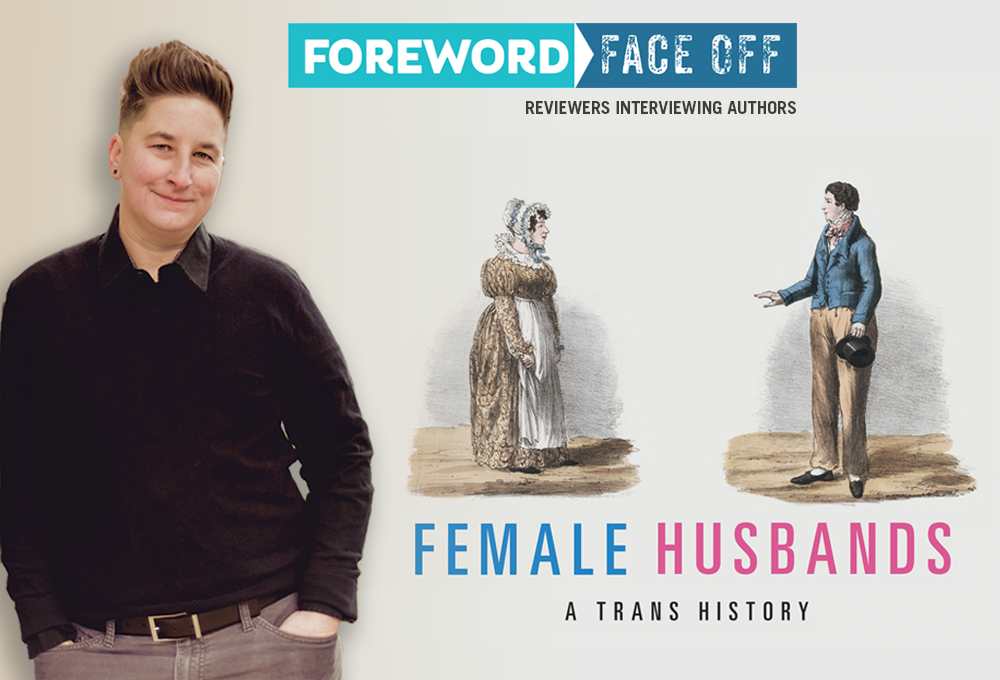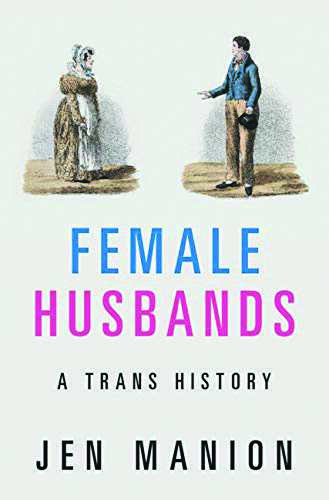Reviewer Eileen Gonzalez Interviews Jen Manion, Author of Female Husbands: A Trans History

There are few experiences more universally human than to strive for belonging. We all long for a slice of a shared history, a touchstone to connect us to something larger than ourselves. Television commercials advertise websites devoted to tracking down ancestors or tests to decode the legacy ingrained in DNA, while reality TV takes celebrities on trips to Ellis Island or reconnects family members thought lost to time or circumstance. But some histories cannot be found in yellowed records or genotypes, the people and their stories systemically suppressed and erased to the point that they are lucky to be found at all.

Queer history has often landed in the crosshairs of such malevolent efforts, but Jen Manion has ensured the truth rises to the top in Female Husbands, a pivotal work exploring an underrepresented period of trans history. The existence of female husbands—individuals who were assigned female at birth but lived and took wives as men—first became well-known in eighteenth-century Britain, and the episode of trans history has been subjected to mischaracterizations ever since.
Intrigued by reviewer Eileen Gonzalez’s luminous review in the May/June issue of Foreword Reviews, we reached out to Cambridge University Press to connect with Jen for an interview to delve further.
Take it away, Eileen!
Trans and gender-nonconforming people have always existed in every corner of the globe. What interested you about the female husbands of the UK and America in particular?
We have known for a while now that trans and GNC people have always existed. That was the first step in recovering our past. But the next step is really to understand these lives within the context of their own time, place, and communities. I came to focus on “female husbands” because I hoped to gain greater depth of understanding of this one particular experience of transing gender. Unlike other kinds of accounts, stories of female husbands were filled with all kinds of details—such as full names of several people, towns, churches, birthdates, marriage dates, etc.—that made it possible to verify the stories in traditional archival records. Plus, female husbands are just really cool.
You did so much research for this book. Most of your sources are contemporary news reports and fictionalized accounts of the female husbands’ lives, which means you were pretty much at the mercy of disrespectful and incomplete reporting. Was it difficult to figure out how much of these accounts you could trust versus how much was sensationalist exaggeration?
I think the challenging nature of the sources is probably a reason more people haven’t extensively worked with these records already. Literary scholars have argued how this style of writing served to intentionally obscure the meaning of such accounts, which I think is true. But the records are too rich and abundant for historians to ignore. Once you read hundreds of the accounts, you develop a way to sort through claims that were likely true and claims that were formulaic and exaggerated. I verified as much as I possibly could in other places, but you can never verify the really subjective details that brought the stories to life. Even though the accounts were sensationalized and often mean and objectifying of my trans and queer ancestors, there are also moments where the records are respectful, understanding, curious, favorable, or neutral. It’s really important for us to know about this past as well!
You note that little attention has been paid, both historically and currently, to the female wives of the female husbands. We know next to nothing about their motivations for entering such marriages, or how and when they learned their female husbands were not assigned male at birth. Why do you think there’s been so little interest in exploring these women’s side of the story?
Great question. There is a longstanding view we inherited from early twentieth century sexology that women who were feminine or femme could not really be “true” homosexuals. Rather, the idea was that they were duped or seduced by gender non-conforming (GNC) or masculine women. The same logic seems to have applied to women who partnered with female husbands. There was tremendous pressure for them to claim that they did not know their husbands were assigned female. This removed any notion of stigma or difference and allowed them to be seen as normative heterosexual women, for the most part. Often, their names were changed or shortened in the newspaper stories of their relationships with female husbands, which makes it nearly impossible to develop fuller biographies for them.
I really appreciate how nuanced the book is. You’re careful to point out how the female husbands benefited from other circumstances, e.g., being white, and you illustrate these advantages through such examples as the story of Charles Williams, a black sailor assigned female at birth. At what point in your research did you notice these trends, and why was it important for you to point them out in the book?
It was pretty quickly apparent that female husbands were common laborers. This wasn’t a life or a category that was applied to wealthy people. I expected to encounter female husbands who were black or Indigenous, but did not. The fact that female husband was a category bound by whiteness is really interesting. For all of the hardships husbands and their wives faced, it was still an experience and category marked by some amount of privilege, freedom, and mobility. I wish I had more room to unpack the role of whiteness, honestly, because it is certainly a pattern in transgender history. Transness for communities of color looked different and we have much more to learn about that.
In chapter six, you discuss how the rise of American women’s suffrage affected public perception of female husbands. Naysayers regarded the apolitical female husbands as something of a cautionary tale, i.e., if women are granted the right to vote, what’s to stop them from abandoning their wifely duties, marrying women, etc. I was especially interested in your observation that “arguments that politics made women into manly people who were undesirable for marriage never really went away.” Could you elaborate on that statement? Do you see this attitude echoed in modern reporting, and how does it relate (if at all) to current narratives and depictions of trans and gender non-conforming people?
Starting in the late eighteenth century when white middle- and upper-class women began fighting for access to formal education and political rights, they were immediately mocked for wanting to be like men. This argument went pretty far in deterring significant numbers of women who recoiled at the accusation they were “masculine.” Female anti-slavery activists were also accused of being too manly as a way to deter their advocacy. I think lots of people would say this view has never gone away and is used to disparage twentieth-century feminists and women who have successful professional careers. The reason I bring it up in the book is that I think it is important for people to see the way gender norms have been used to mock, punish, and restrict peoples’ lives for a long time. Everyone assigned female—whether they go on to identify as transgender, lesbians, women, feminists, or some combination of those categories—has been restricted by norms that punish women for wanting to be strong, smart, ambitious, aggressive, physical, independent, educated, powerful, etc.
If you had a time machine and could meet any or all of the female husbands in your book, is there anything you would want to say to them?
I think my heart breaks the most for Joseph Lobdell because of how they were treated in the final decades of their life—ripped away from their wife and institutionalized for decades. But what would I say: I’m sorry? Thank you? Nothing really seems sufficient.
I have become the fondest of James Howe, probably because so much was written about them over a long period of time. You can get a pretty clear picture of their life—and also see how attitudes toward female husbands changed from that of curious respect in the 1760s to that of mocking disdain in the 1850s. If I could get to the bottom of one thing about their lives, it would be to understand their relationships. Who were their wives to them? Were their relationships markedly different from those of other married couples at the time? And finally, did they feel free and happy in their lives or restrained and fearful?
Eileen Gonzalez
